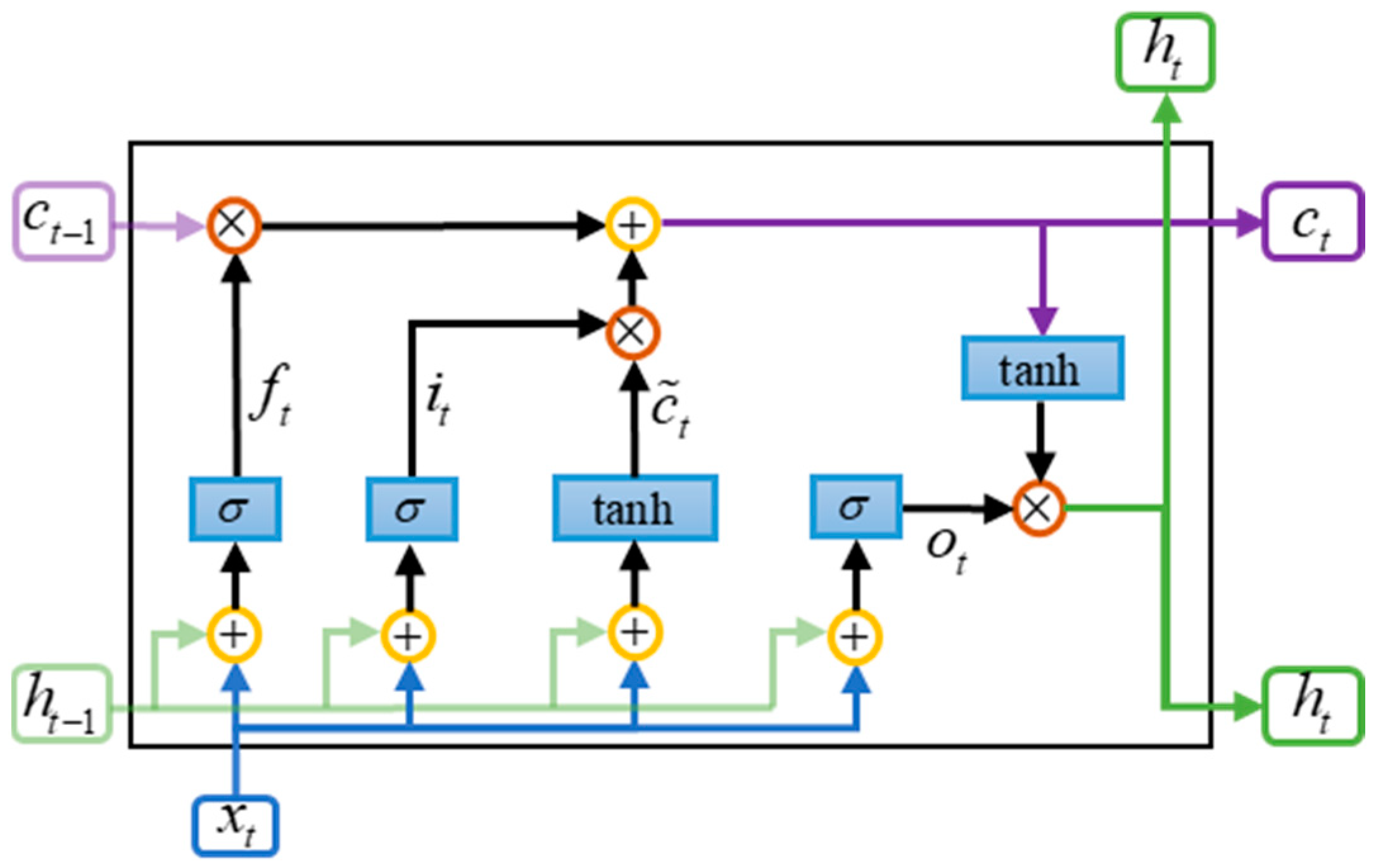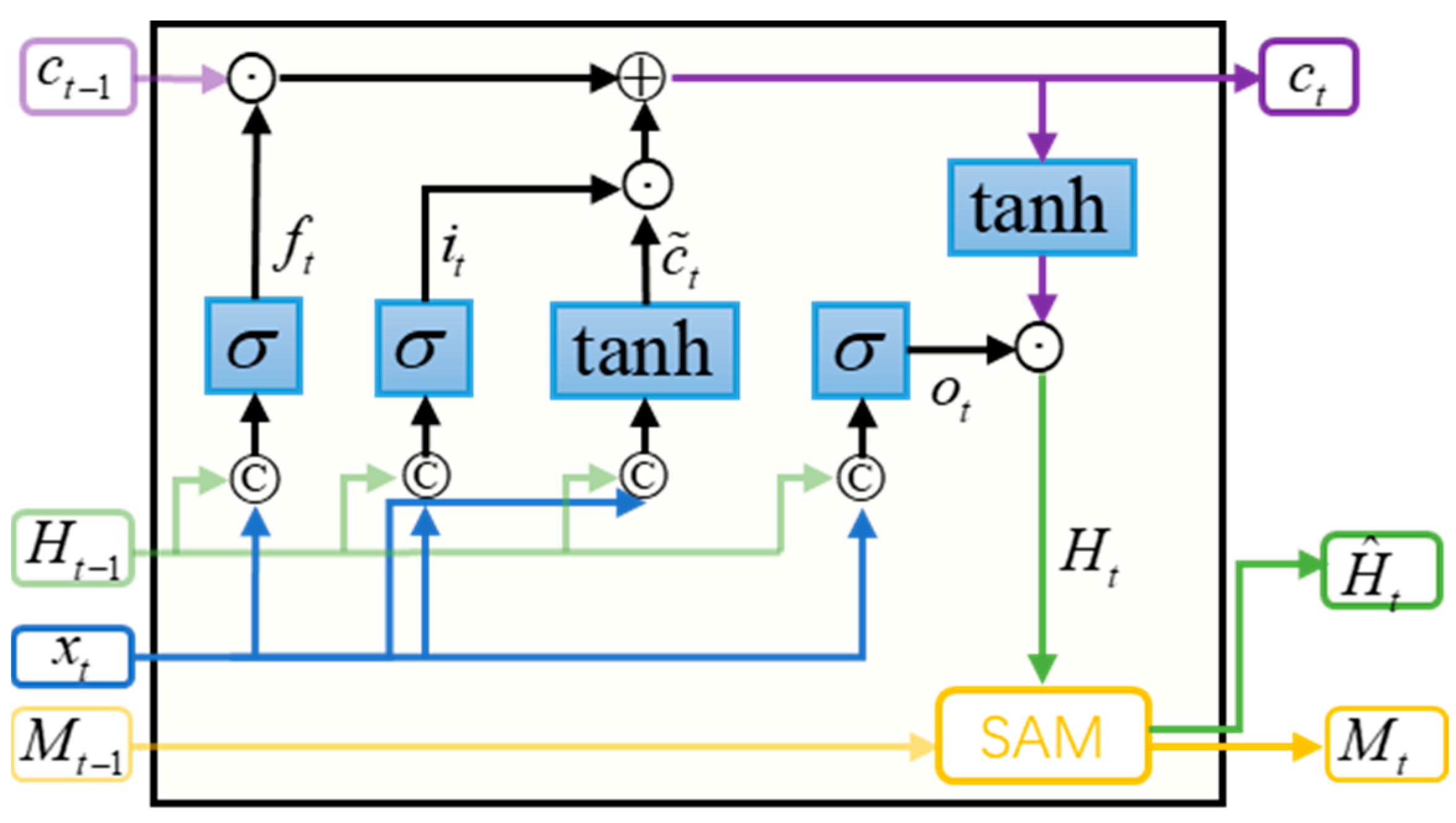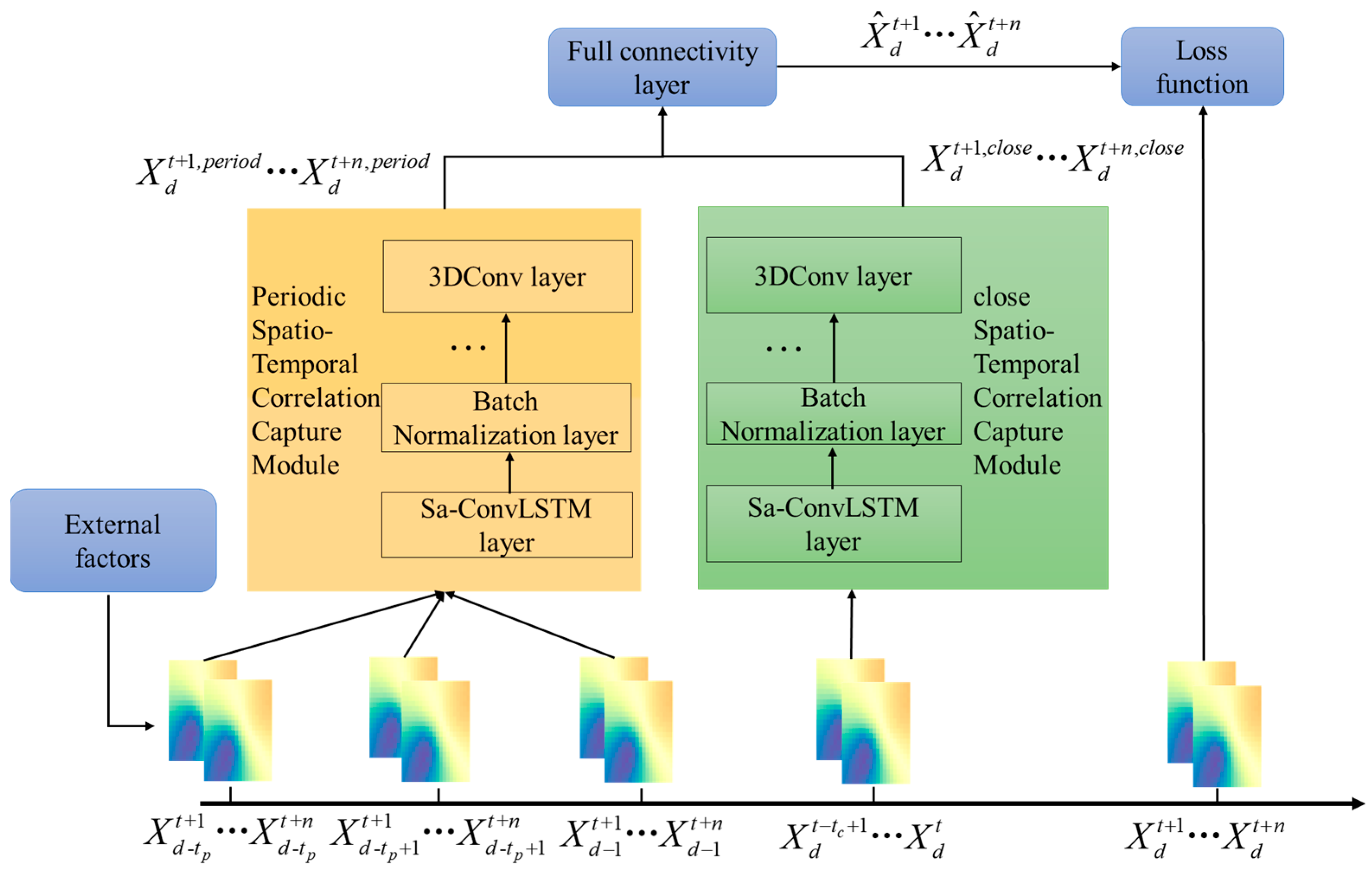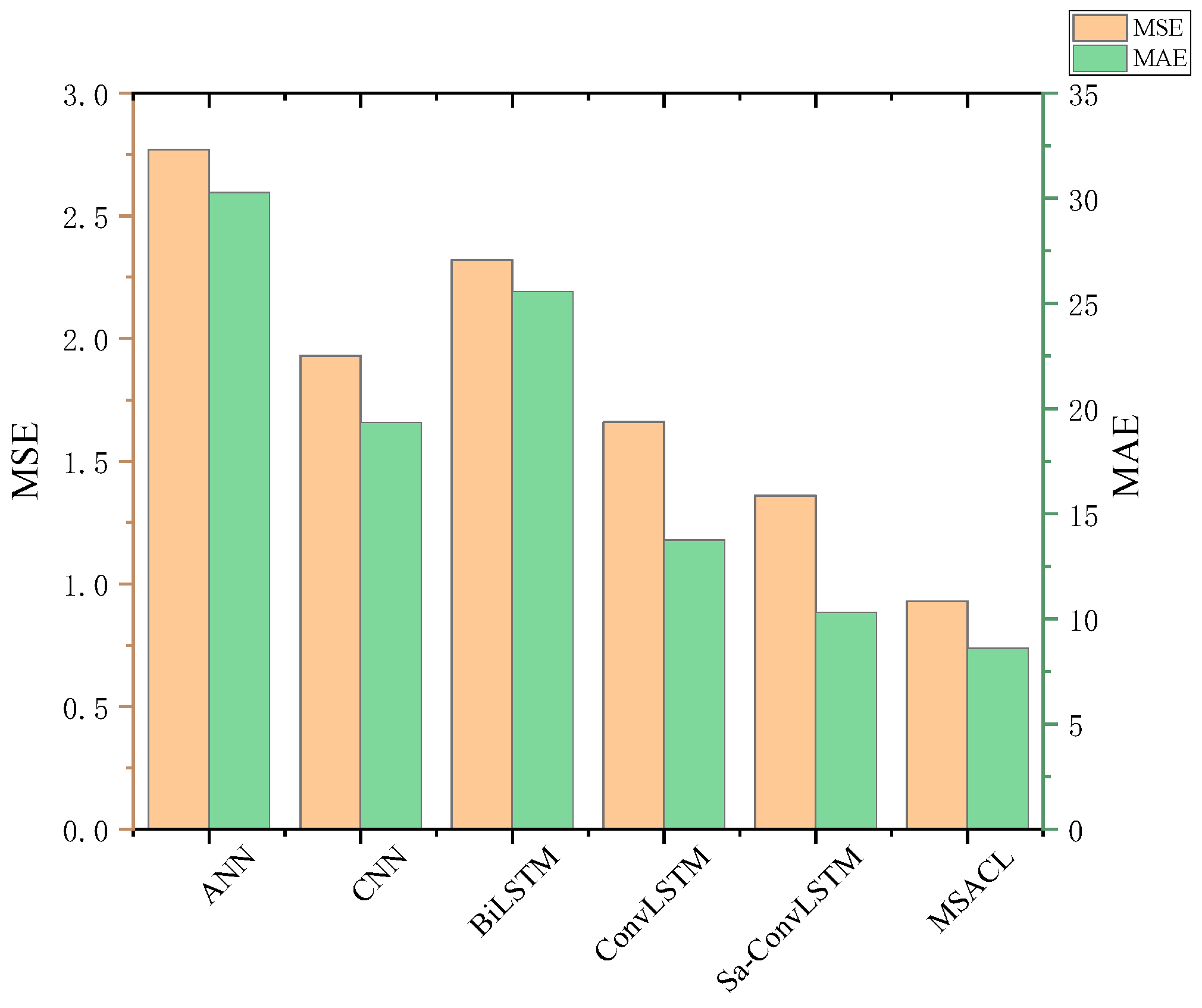Prediction on Demand for Regional Online Car-Hailing Travel Based on Self-Attention Memory and ConvLSTM
Abstract
:1. Introduction
1.1. Trends in the Development of Online Car-Hailing
1.2. Related Work
1.3. Contributions and Structure of This Paper
- (1)
- To obtain long-term spatiotemporal dependence, Sa-ConvLSTM was used as the basic structure instead of a simple attention mechanism and ConvLSTM for connection.
- (2)
- We constructed a multi-input spatiotemporal prediction model (MSACL) using SA-ConvLSTM as the basic structure. Its inputs include multidimensional spatiotemporal series as well as external factor time series.
2. Preliminaries
2.1. Defining
2.2. Description of the Problem
3. Methodology
3.1. ConvLSTM
3.2. Sa-ConvLSTM
3.3. Proposed Model
4. Experiment
4.1. Data Sets
4.2. Evaluation Indicators
4.3. Training Configuration
4.4. Baseline Model
- (1)
- Artificial Neural Network (ANN): ANN is the basis of all types of neural networks. All types of neural networks are optimized based on this neural network.
- (2)
- 3DCNN: 3DCNN is a type of neural network that includes convolutional computation. In traffic prediction, each grid is set as a pixel point, and the traffic state is regarded as an image, which is used as the input to the convolutional neural network.
- (3)
- BiLSTM: BiLSTM combines forward LSTM and reverse LSTM to extract bidirectional time series information to improve prediction accuracy.
- (4)
- ConvLSTM: As mentioned above, ConvLSTM introduces the convolution operation into the LSTM model to extract spatiotemporal information simultaneously.
- (5)
- Sa-ConvLSTM: ConvLSTM inlaid with a SAM module.
4.5. Comparison Experiment
- (1)
- Compared with the Sa-ConvLSTM model, our proposed model has further improved in prediction accuracy, which indicates the effectiveness of our proposed model. The cycle-time correlation capturing module and external factors play a role in the improvement of prediction performance.
- (2)
- Compared with the ConvLSTM model, Sa-ConvLSTM also shows some improvement. This result verifies that the self-attentive memory (SAM) module does capture long-term dependent spatial features, and spatiotemporal features are further mined.
- (3)
- The CNN fails to extract the time-dependent features, so the prediction performance of this model is not as good as ConvLSTM, Sa-ConvLSTM, and our proposed model.
- (4)
- In spatiotemporal prediction, the effective extraction of spatial dependence improves the performance of the model more, the 3DCNN model can only extract spatial features effectively, and the BiLSTM model can only extract temporal correlation, while the prediction of 3DCNN is superior to the BiLSTM model.
4.6. Ablation Experiment
- (1)
- MSACL-P, which removes the period spatiotemporal correlation capture module compared to the full model, is used to verify the effectiveness of the period spatiotemporal correlation capture module.
- (2)
- MSACL-SA, compared to the full model, which removes the SAM module and is used to validate the effectiveness of the self-attentive memory module.
- (3)
- MSACL-EX, compared to the full model, which removes external factors and is used to validate the effectiveness of external factors.
5. Conclusions
Author Contributions
Funding
Data Availability Statement
Conflicts of Interest
References
- Teng, F.; Teng, J.; Qiao, L.; Du, S.; Li, T. A multi-step forecasting model of online car-hailing demand. Inf. Sci. 2022, 587, 572–586. [Google Scholar] [CrossRef]
- Shuai, C.; Zhang, X.; Wang, Y.; He, M.; Yang, F.; Xu, G. Online Car-Hailing Origin-Destination Forecast Based on a Temporal Graph Convolutional Network. IEEE Intell. Transp. Syst. Mag. 2023, 15, 121–136. [Google Scholar] [CrossRef]
- Zhang, B.; Chen, S.; Ma, Y.; Li, T.; Tang, K. Analysis on spatiotemporal urban mobility based on online car-hailing data. J. Transp. Geogr. 2020, 82, 102568. [Google Scholar] [CrossRef]
- Ye, X.; Ye, Q.; Yan, X.; Wang, T.; Chen, J.; Li, S. Demand Forecasting of Online Car-Hailing with Combining LSTM+ Attention Approaches. Electronics 2021, 10, 2480. [Google Scholar] [CrossRef]
- Bi, H.; Ye, Z.R.; Wang, C.; Chen, E.H.; Li, Y.H.; Shao, X.M. How Built Environment Impacts Online car-hailing Ridership. Transp. Res. Rec. J. Transp. Res. Board 2020, 2674, 745–760. [Google Scholar] [CrossRef]
- Li, T.; Jing, P.; Li, L.C.; Sun, D.Z.; Yan, W.B. Revealing the varying impact of urban built environment on online car-hailing travel in spatio-temporal dimension: An exploratory analysis in Chengdu, China. Sustainability 2019, 11, 1336. [Google Scholar] [CrossRef]
- Zhao, G.W.; Li, Z.T.; Shang, Y.Z.; Yang, M.Z. How does the urban built environment affect online car-hailing ridership intensity among different scales? Int. J. Environ. Res. Public Health 2022, 19, 5325. [Google Scholar] [CrossRef] [PubMed]
- Wang, Z.; Wang, Y.; Muhammad, K. Network Car Hailing Pricing Model Optimization in Edge Computing-Based Intelligent Transportation System. IEEE Trans. Intell. Transp. Syst. 2023, 24, 13286–13295. [Google Scholar] [CrossRef]
- Zuo, W.; Zhu, W.; Chen, S.; He, X. Service quality management of online car-hailing based on PCN in the sharing economy. Electron. Commer. Res. Appl. 2019, 34, 100827. [Google Scholar] [CrossRef]
- Xu, J.; Rahmatizadeh, R.; Boloni, L.; Turgut, D. Real-Time Prediction of Taxi Demand Using Recurrent Neural Networks. IEEE Trans. Intell. Transp. Syst. 2018, 19, 2572–2581. [Google Scholar] [CrossRef]
- Jiang, X.M.; Adeli, H. Dynamic wavelet neural network model for traffic flow forecasting. Transp. Eng. 2005, 131, 771–779. [Google Scholar] [CrossRef]
- Shah, I.; Muhammad, I.; Ali, S.; Ahmed, S.; Almazah, M.M.A.; Al-Rezami, A.Y. Forecasting Day-Ahead Traffic Flow Using Functional Time Series Approach. Mathematics 2022, 10, 4279. [Google Scholar] [CrossRef]
- Lin, X.; Huang, Y. Short-Term High-Speed Traffic Flow Prediction Based on ARIMA-GARCH-M Model. Wirel. Pers. Commun. 2021, 117, 3421–3430. [Google Scholar] [CrossRef]
- Zhang, Y.; Shang, K.; Cui, Z.; Zhang, Z.; Zhang, F. Research on traffic flow prediction at intersections based on DT-TCN-attention. Sensors 2023, 23, 6683. [Google Scholar] [CrossRef] [PubMed]
- Liao, L.; Li, B.; Zou, F.; Huang, D. MFGCN: A Multimodal Fusion Graph Convolutional Network for Online Car-Hailing Demand Prediction. IEEE Intell. Syst. 2023, 38, 21–30. [Google Scholar] [CrossRef]
- Bi, S.; Yuan, C.; Liu, S.; Wang, L.; Zhang, L. Spatiotemporal Prediction of Urban Online Car-Hailing Travel Demand Based on Transformer Network. Sustainability 2022, 14, 13568. [Google Scholar] [CrossRef]
- Ye, X.; Sui, X.; Wang, T.; Yan, X.; Chen, J. Research on parking choice behavior of shared autonomous vehicle services by measuring users’ intention of usage. Transp. Res. Part F Traffic Psychol. Behav. 2022, 88, 81–98. [Google Scholar] [CrossRef]
- Jiang, S.; Chen, W.; Li, Z.; Yu, H. Short-term Demand Prediction Method for Online Car-hailing Services Based on a Least Squares Support Vector Machine. IEEE Access 2019, 7, 11882–11891. [Google Scholar] [CrossRef]
- Liu, J.; Tang, X.; Liu, H. Enhanced forecasting of online car-hailing demand using an improved empirical mode decomposition with long short-term memory neural network. Transp. Lett. 2024, 1–17. [Google Scholar] [CrossRef]
- Lu, X.; Ma, C.; Qiao, Y. Short-term demand forecasting for online car-hailing using Conv-LSTM networks. Phys. A Stat. Mech. Its Appl. 2021, 570, 125838. [Google Scholar] [CrossRef]
- Ke, J.; Zheng, H.; Yang, H.; Chen, X. Short-term forecasting of passenger demand under on-demand ride services: A spatio-temporal deep learning approach. Transp. Res. Part C Emerg. Technol. 2017, 85, 591–608. [Google Scholar] [CrossRef]
- Wang, D.; Yang, Y.; Ning, S. Deepstcl: A Deep Spatio-Temporal Convlstm for Travel Demand Prediction. In Proceedings of the 2018 International Joint Conference on Neural Networks (IJCNN), Rio de Janeiro, Brazil, 8–13 July 2018; pp. 1–8. [Google Scholar]
- Ge, H.; Li, S.; Cheng, R.; Chen, Z. Self-Attention ConvLSTM for Spatiotemporal Forecasting of Short-Term Online Car-Hailing Demand. Sustainability 2022, 14, 7371. [Google Scholar] [CrossRef]
- Guo, G.; Zhang, T. A residual spatio-temporal architecture for travel demand forecasting. Transp. Res. Part C: Emerg. Technol. 2020, 115, 102639. [Google Scholar] [CrossRef]
- Zhang, J.; Zheng, Y.; Qi, D. Deep spatio-temporal residual networks for citywide crowd flows prediction. In Proceedings of the AAAI Conference on Artificial Intelligence, San Francisco, CA, USA, 4–9 February 2017; pp. 1655–1661. [Google Scholar] [CrossRef]
- Liu, Z.; Liu, X.; Wang, Y.; Yan, X. Coupling travel characteristics identifying and deep learning for demand forecasting on car-hailing tourists: A case study of Beijing, China. IET Intell. Transp. Syst. 2024, 18, 691–708. [Google Scholar] [CrossRef]
- Ye, X.; Hao, Y.; Ye, Q.; Wang, T.; Yan, X.; Chen, J. Demand forecasting of online car-hailing by Exhaustively capturing the temporal dependency with TCN and Attention approaches. IET Intell. Transp. Syst. 2023; Early View. [Google Scholar] [CrossRef]
- Hochreiter, S.; Schmidhuber, J. Long short-term memory. Neural Comput. 1997, 9, 1735–1780. [Google Scholar] [CrossRef] [PubMed]
- Shi, X.; Chen, Z.; Wang, H.; Yeung, D.; Wong, W.; Woo, W. Convolutional LSTM Network: A Machine Learning Approach for Precipitation Nowcasting. Adv. Neural Inf. Process. Syst. 2015, 1, 802–810. [Google Scholar] [CrossRef]
- Lin, Z.; Li, M.; Zheng, Z.; Cheng, Y.; Yuan, C. Self-Attention ConvLSTM for Spatiotemporal Prediction. In Proceedings of the AAAI Conference on Artificial Intelligence, New York, NY, USA, 7–12 February 2020; pp. 11531–11538. [Google Scholar] [CrossRef]
- Vaswani, A.; Shazeer, N.; Parmar, N.; Uszkoreit, J.; Jones, L.; Gomez, A.N.; Polosukhin, I. Attention Is All You Need. Adv. Neural Inf. Process. Syst. 2017, 30, 6000–6010. [Google Scholar]
- Ioffe, S.; Szegedy, C. Batch Normalization: Accelerating Deep Network Training by Reducing Internal Covariate Shift. Int. Conf. Mach. Learn. 2015, 37, 448–456. [Google Scholar] [CrossRef]
- Didi Chuxing. Available online: https://outreach.didichuxing.com (accessed on 1 March 2021).
- Zeng, W.; Wang, K.; Zhou, J.; Cheng, R. Traffic Flow Prediction Based on Hybrid Deep Learning Models Considering Missing Data and Multiple Factors. Sustainability 2023, 15, 11092. [Google Scholar] [CrossRef]
- Cheng, R.; Zeng, W.; Wu, X.; Miao, B. Exploring the Influence of the Built Environment on the Demand for Online Car-Hailing Services Using a Multi-Scale Geographically and Temporally Weighted Regression Model. Sustainability 2024, 16, 1794. [Google Scholar] [CrossRef]






| Driver ID | Order ID | Timestamp | Longitude | Latitude |
|---|---|---|---|---|
| ****** | ****** | 1477969149 | 104.0749 | 30.73734 |
| Time | Quantity of Rainfall | Average Temperatures | Whether It Is a Working Day |
|---|---|---|---|
| 1 November 2016 0:00:00 | 0.0 | 17.8 | 0 |
| Projects | Version and Parameters |
|---|---|
| CPU Version | 12 vCPU Inter Xeon ® Platinum 8255C CPU @2.50 Ghz |
| GPU Version | RTX 3080 |
| Number of GPUs | 1 |
| Tensorflow Version | 2.9.0 |
| Cuda Version | 11.2 |
| Python Version | 3.8 |
| Name | Parameters |
|---|---|
| Convolution kernel number of Sa-ConvLSTM | 15 |
| Convolution kernel size of Sa-ConvLSTM | 3 × 3 |
| Convolution kernel number of 3DCNN | 15 |
| Convolution kernel size of 3DCNN | 3 × 3 × 3 |
| Optimizer | Adam |
| Learning rate | 0.01 |
| Predicted step | 12 |
| Batch size | 32 |
| Number of training sessions | 100 |
| Model | Evaluation Indicators | ||
|---|---|---|---|
| MAE | MSE | R2 | |
| ANN | 30.27 | 2.77 | 71.25% |
| 3DCNN | 19.34 | 1.93 | 81.67% |
| BiLSTM | 25.56 | 2.32 | 75.33% |
| ConvLSTM | 13.75 | 1.66 | 85.89% |
| Sa-ConvLSTM | 10.32 | 1.36 | 87.64% |
| MSACL | 8.60 | 0.93 | 91.64% |
| Model | Evaluation Indicators | ||
|---|---|---|---|
| MAE | RMSE | R2 | |
| MSACL-P | 8.83 | 1.13 | 90.12% |
| MSACL-SA | 8.87 | 1.23 | 89.91% |
| MSACL-EX | 8.73 | 1.01 | 90.62% |
| MSACL | 8.60 | 0.93 | 91.64% |
Disclaimer/Publisher’s Note: The statements, opinions and data contained in all publications are solely those of the individual author(s) and contributor(s) and not of MDPI and/or the editor(s). MDPI and/or the editor(s) disclaim responsibility for any injury to people or property resulting from any ideas, methods, instructions or products referred to in the content. |
© 2024 by the authors. Licensee MDPI, Basel, Switzerland. This article is an open access article distributed under the terms and conditions of the Creative Commons Attribution (CC BY) license (https://creativecommons.org/licenses/by/4.0/).
Share and Cite
Li, J.; Zeng, W.; Liu, W.; Cheng, R. Prediction on Demand for Regional Online Car-Hailing Travel Based on Self-Attention Memory and ConvLSTM. Sustainability 2024, 16, 5725. https://doi.org/10.3390/su16135725
Li J, Zeng W, Liu W, Cheng R. Prediction on Demand for Regional Online Car-Hailing Travel Based on Self-Attention Memory and ConvLSTM. Sustainability. 2024; 16(13):5725. https://doi.org/10.3390/su16135725
Chicago/Turabian StyleLi, Jianqi, Wenbao Zeng, Weiqi Liu, and Rongjun Cheng. 2024. "Prediction on Demand for Regional Online Car-Hailing Travel Based on Self-Attention Memory and ConvLSTM" Sustainability 16, no. 13: 5725. https://doi.org/10.3390/su16135725
APA StyleLi, J., Zeng, W., Liu, W., & Cheng, R. (2024). Prediction on Demand for Regional Online Car-Hailing Travel Based on Self-Attention Memory and ConvLSTM. Sustainability, 16(13), 5725. https://doi.org/10.3390/su16135725






